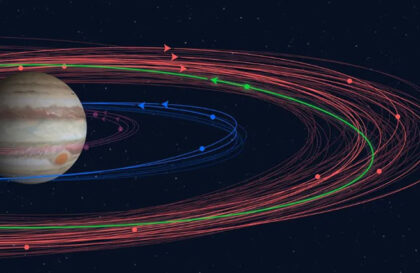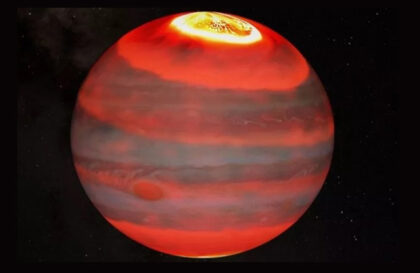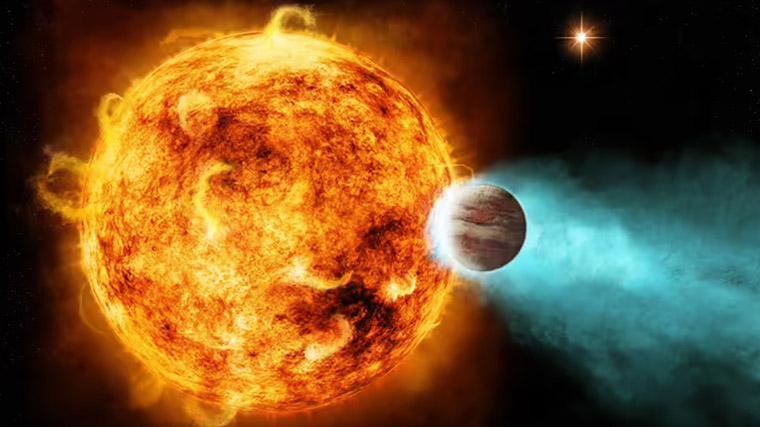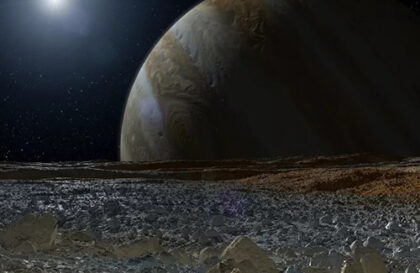The small moon Io (slightly larger than our Moon) significantly influences the parent Jupiter (more than 1300 Earths can fit inside Jupiter). Its orbit crosses Jupiter’s powerful magnetic field lines, turning it into an electrical generator. According to NASA, Io can generate over 400,000 volts, creating an electrical current of 3 million amperes. This electric current returns along Jupiter’s magnetic lines, causing lightning storms in its upper atmosphere.
The largest volcano in the Solar System
In July 2022, Jeff Morgenthaler of the Royal Observatory of Belgium observed one of Io’s most significant volcanic eruptions. To capture Io’s surface, Morgenthaler used a coronagraph to separate the brightness near Io from that of Jupiter. This allowed him to notice the presence of sulfur and sodium emission lines. Io volcanic activity was recorded from July to September 2022 and continued until December.
The eruption changed the appearance of Io; the surface became variegated and colorful, and lava flows stretched for hundreds of kilometers. In addition, the eruption affected the plasmasphere around Io, which may have something to do with Juno’s instruments. So, to study Io’s physical characteristics, Juno plans to get closer and take new images of volcanoes and other features.
Is the largest volcanic depression on Jupiter’s moon Io, 202 kilometers (126 mi) in diameter. Credit: NASA/JPL/USGS – http://photojournal.jpl.nasa.gov/catalog/PIA00320
Numerous volcanoes and sulfur deposits give it a bright yellow-white-orange color. Its volcanic activity is characterized by increased brightness in the sodium and sulfur radiation lines and lasts three to six months.
NASA’s Voyager mission first discovered Io’s volcanic activity in 1979.
Sulfur dioxide and sulfur vapor are emitted from the craters of volcanoes at a speed of about 1 km/s. There are 20 active volcanoes on Io, spewing plumes up to 180 miles (300 km) high. The highest eruption on Earth reached 60-70 kilometers from the eruption of Mount Taupo in 186 BC. To appreciate the scale of the action on Io, imagine an eruption on Earth that would send a plume 350 miles (560 kilometers) high. It’s very tall. The International Space Station orbits at an altitude of about 250 miles (400 kilometers).
On Earth, the average mass erupted by a volcano is 100-1000 m3/s. The peak eruption rate on Io is much higher – 6000 – 18,000 m3/s.
Io is the fifth most distant moon from Jupiter and the closest of the Galilean moons between Thebes and Europa. It was discovered by Galileo Galilei in 1610 and is the fourth-largest moon with a diameter of 2,263 miles (3,642 kilometers). One revolution around Jupiter takes 42.5 hours.
The gravitational influence of Jupiter, on the one hand, and its other moons, especially Europa and Ganymede, cause significant tidal fluctuations on Io. These vibrations cause its surface to bulge up to 330 feet (100 meters). This intense interaction releases enormous amounts of heat on Io, which is 20 times greater than Earth’s heat flow. The continuous gravitational influence from Europa and Ganymede causes Io’s orbit to change into an elliptical shape, maintaining a constant tidal heating process.
Io’s main features are a dark ring rim located several hundred kilometers from a caldera (a geological formation that occurs as a result of volcanic eruptions and the formation of giant craters as a result of the collapse of volcanic magma or the eruption of hot gases), and an orbit that is not the closest to the gas giant of all bodies.
Io is the most volcanically active world in the Solar System, with hundreds of active erupting volcanoes, as evidenced by NASA’s Juno spacecraft conducting a series of satellite flybys. Certain features on Io’s surface, such as the mottled and colored surface, are created by these vents.
All these features create a unique Io atmosphere, making it different from other satellites. There is neither water nor frost in Io’s volcanic emissions. Whether the satellite was always “dry” is a mystery because Ganymede and Callisto are 50-60% water ice.
The atmosphere on Io is 10 million times thinner than on Earth. Atmospheric pressure is a billion times less.
Fast facts:
This montage of images of Jupiter and its volcanic moon Io was taken by the New Horizons spacecraft’s flyby in early 2007. Credit:
NASA/Johns Hopkins University Applied Physics Laboratory/Southwest Research Institute/Goddard Space Flight Center
The age of Io is about 4.5 billion years. It was formed at about the same time as Jupiter. It is in the fifth orbit from Jupiter, at an average distance of approximately 262,000 miles (422,000 km), and makes a complete revolution around the planet in 1.77 Earth days.
Io always faces Jupiter with one side due to tidal capture. Its average radius is 1,131.7 miles (1,821.3 km), slightly larger than the Earth’s Moon.
Io has a slightly elongated shape with the longest axis directed to Jupiter and is the third largest among the Galilean satellites, behind Ganymede and Callisto, but surpasses Europa in mass and volume.
The average temperature on the surface of Io is about minus 202 degrees Fahrenheit (minus 130 degrees Celsius), resulting in snowfields of sulfur dioxide. Volcanic activity can raise temperatures to 3,000 degrees Fahrenheit (1,649 degrees Celsius).
At its closest point to Earth, when Jupiter and Earth are on the same side of the Sun, the distance to Io can be as little as 365 million miles (588 million km). It is almost ten times farther than Mars.
Missions on Io
No special missions were sent to Io. However, it was observed by several devices. NASA’s Pioneer 10 and Pioneer 11 viewing Jupiter in 1973 and 1974, and Voyager 1 and Voyager 2 in 1979. From 1995 to 2002, NASA’s Galileo spacecraft made several flybys of Io, providing detailed images of the moon. The Cassini spacecraft also explored Io in 2000 on its way to Saturn.
Banner image: The volcano Loki on the moon Io. Credit: NASA.
Image credit:
https://www.express.co.uk
https://commons.wikimedia.org
https://www.nasa.gov






